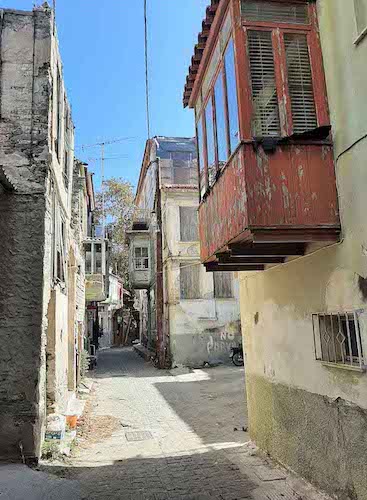I was raised in the northwest of the Netherlands and I always regretted that I didn’t live in the south, where the weather is more beautiful and warmer. I was hoping that my life would develop in the south: the south of France, Italy or Spain. Although nowadays with climate change it is warm everywhere.
Now I do have a more southerly house than where I grew up, but it is in the north of the island of Lesvos. Here too the north is the cold side and the south the warm side. The centre of the tourism is in the cool north, around Molyvos, the most beautiful little town the island has on offer. That is why most of the visitors have no idea what the warmer side of Lesvos looks like.
Each time I drive along the south coast, I am impressed by the very different, intense tinkling light and remember the dreams of the south I had when I was young. How the sun here looks out over the water makes it a dazzling light party. Just follow the endless long beach of Vatera or the beautiful coastal road from Plomari to Melinda.
Plomari is called the capital of the south, as well as the second city of Lesvos. Not even two centuries ago it stretched into the mountains, where now lies the village of Megalochori. It was the centre of eighteen villages: Plumaria. The main living was made from olives—that was until catastrophic wild fires destroyed the region. Luckily, at that time, the pirates had finally been chased away from the Greek seas; allowing a large part of the inhabitants to move towards the mouth of the Sedoundas river where they built houses and started new businesses at the seaside.
This movement had also taken inspiration from the philosophies of Benjamin of Lesvos (1759 – 1824), a wise monk, born in Plumaria and known for, amongst other things, his school in Ayvalik and his enlightened ideas about a new economy. When soap factories and olive presses emerged at the seaside, ship builders from the Cyclads, Kythara and Psara came to build ships, with the commercial fleet of Plomari growing over two hundreds ships. Efstratios Varvayannis, grown up in Russian Odessa, also answered the call for new economics and started the first ouzo distillery around 1860.
Le Grand Siecle of Plomari lasted until 1912. The liberation of Lesvos meant the fall of the booming commerce with overseas communities in Micro Asia and around the Black Sea. The ten olive presses, four soap factories and an olive pit factory slowly went broke. More than half of the people went to the big cities or emigrated to South Africa, Australia or Venezuela.
Nowadays, nowhere on Lesvos will you find as many modern villas as those around Plomari: glued to steep mountainsides and dominating the mountain tops. Plomari’s latest business: 4 local and 10 Danish architects. However, down at the harbourside, it still looks like the Sixties because of the typical boring angular buildings from those times and the ruins of those big factories. Entering the quarter behind the harbour, only then the rich past of Plomari welcomes.
It is a beautiful adventure to wander along the small tortuous little streets around the centre, where stately and charming houses shine out, as if the lively international commerce had never faded away. Smaller houses with their protruding wooden extensions of the upper floors floating out over the streets, are all worth a photograph. During the last big earthquake, in 2017, the condition of many dilapidated buildings became even more perilous, but thanks to subsidies lots of work is taking place now to restore these ruins. Plomari wants to become as picturesque as Molyvos.
Last summer a record number of tourists visited Lesvos, the bulk of them staying in the north. Elsewhere, like in Plomari, their numbers were also on the rise. But no other villages overflowed with people to the extent that Molivos and Petra did. It would be good next summer to spread the tourists: those who love to go to beaches without sun beds and crowds should go west, to the quiet extended beaches surrounding lovely white Sigri. For more adventurous holidays at the seaside and in the mountains there is the lively Plomari, close to the commercial beach of Agios Isidoros, the enchanting and authentic Melinda with its colourful pebbles and a little further, over the mountains, the magical Drota. West, South-west and South, there you will find the new hotspots of Lesvos.











